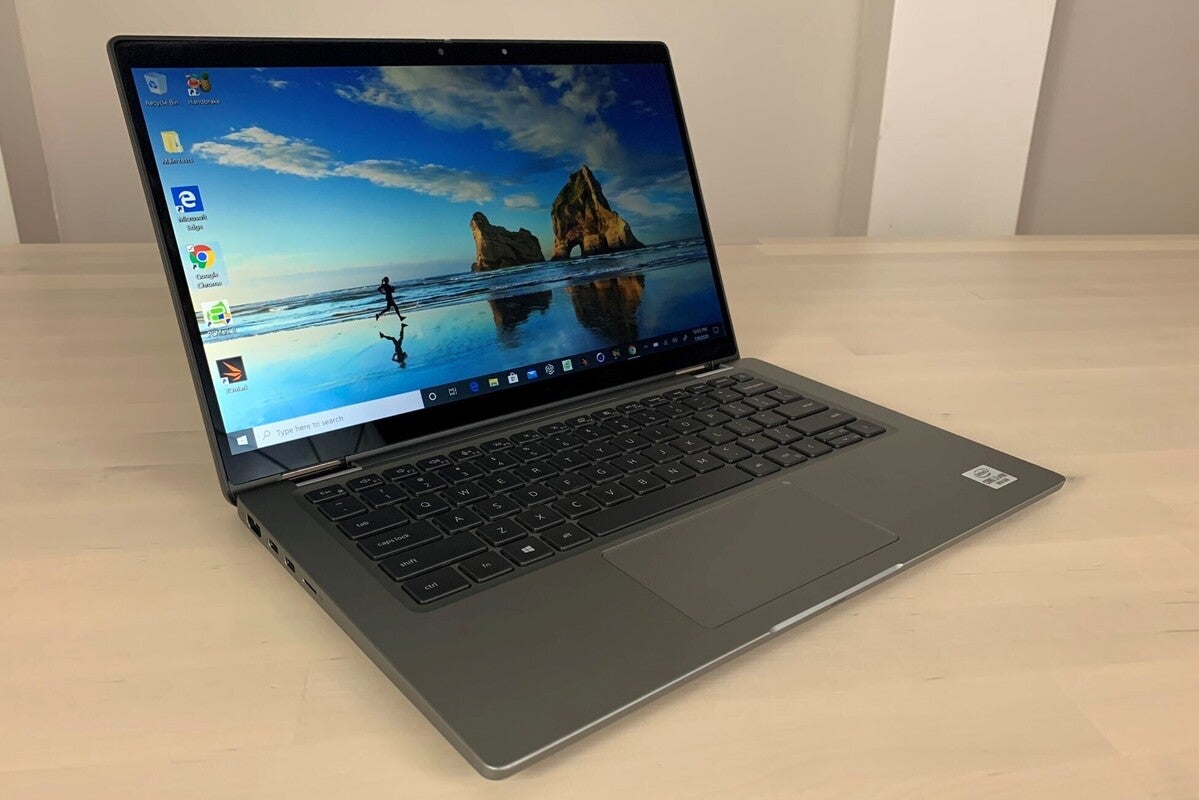The 13.3-inch Latitude 7310’s privacy screen and proximity sensor will foil nosy neighbors.
Ben Patterson/IDG
Today’s Best Tech Deals
Picked by PCWorld’s Editors
Top Deals On Great Products
Picked by Techconnect’s Editors
Show More
Corporate users who put a premium on privacy—particularly when it comes to snoopers in the immediate vicinity—will appreciate the robust security features built into the Dell Latitude 7310. This 13.3-inch convertible laptop not only comes with a proximity sensor that locks and wakes the screen as you come and go, it also boasts a privacy screen that hides sensitive data (although not necessarily images) from prying eyes.
Besides its privacy features, the Latitude 7310’s Core i7 Comet Lake CPU makes mincemeat of single-core computing tasks, and it does an impressive job at handling heavy processor loads over time. On the other hand, we felt that this laptop was a tad hefty for its size.
This review is part of our ongoing roundup of the best laptops. Go there for information on competing models and how we tested them.
Configuration
The Dell Latitude 7310 comes in eight customizable configurations, ranging from a Core i5-10310U-powered version with 8GB of RAM and a 256GB solid-state drive for a list price of $2,455.71 to a Core i7-10610U system with 32GB of RAM and a 1TB SSD for an MSRP of $4,632.44.
If those prices sound steep, bear in mind their corporate-class features, which rarely or never appear on less-expensive laptops for consumers. Many of these models are also steeply discounted on Dell.com.
Here are the details for our built-to-order review unit, which currently sells for a little over $3,800 on Dell.com, or around $2,700 after discounts:
- CPU: Intel Core i7-10610U vPro
- Memory: 16GB DDR4-2666
- Graphics: Integrated Intel UHD Graphics
- Storage: M.2 512GB PCIe NVMe SSD
- Display: 13.3-inch 1920×1080 SafeScreen
- Webcam: 720p with privacy shutter
- Connectivity: Two Thunderbolt 3 ports, one SuperSpeed USB 3.2 Gen 1 Type-A port, full HDMI port, microSD memory card slot, combo audio jack
- Networking: Wi-Fi 6 (802.11ax)
- Biometrics: IR facial recognition, proximity sensor
- Battery capacity: 51 watt-hour
- Dimensions: 12.07 x 8 x 0.72 (rear) inches
- Weight: 3.2 pounds (measured), 3.8 pounds (with power brick)
What really caught our eye with this particular configuration of the Dell Latitude 7310 is its arsenal of privacy and security features. While this particular BTO configuration of the Latitude lacks a fingerprint reader, it does come equipped with IR facial recognition, a proximity sensor, a webcam shutter, and Dell’s SafeScreen privacy display. The CPU includes Intel’s vPro technology, which is designed to optimize remote maintenance and management for IT departments,
Other features worthy of mention include the full HDMI port for connecting an external monitor, a pair of Thunderbolt 3 ports, a USB-A port for legacy accessories (think mice and printers), support for cutting-edge Wi-Fi 6 routers, and a relatively beefy 51-watt hour battery (keep reading for our battery drain results).
Design
The Dell Latitude 7310, like most in this product line, feels sleek, sturdy, and a tad heavy at about 3.2 pounds (or 3.8 if you include the AC cable and power brick). The Latitude 7310 boasts a brushed-aluminum chassis whose ruggedized shell has also been designed to meet MIL-STD 810G standards for sand, dust, vibration, shock, and high/low temperature resistance.
 Ben Patterson/IDG
Ben Patterson/IDGThe Dell Latitude 7310 comes with a brushed aluminum lid and a ruggedized shell designed to meet MIL-STD 810G standards.
The angled front edge of the Latitude has a wide notch that makes it easier to open the laptop with one hand. A pair of 360-degree hinges let you rotate the laptop from clamshell to “tent” to tablet mode.
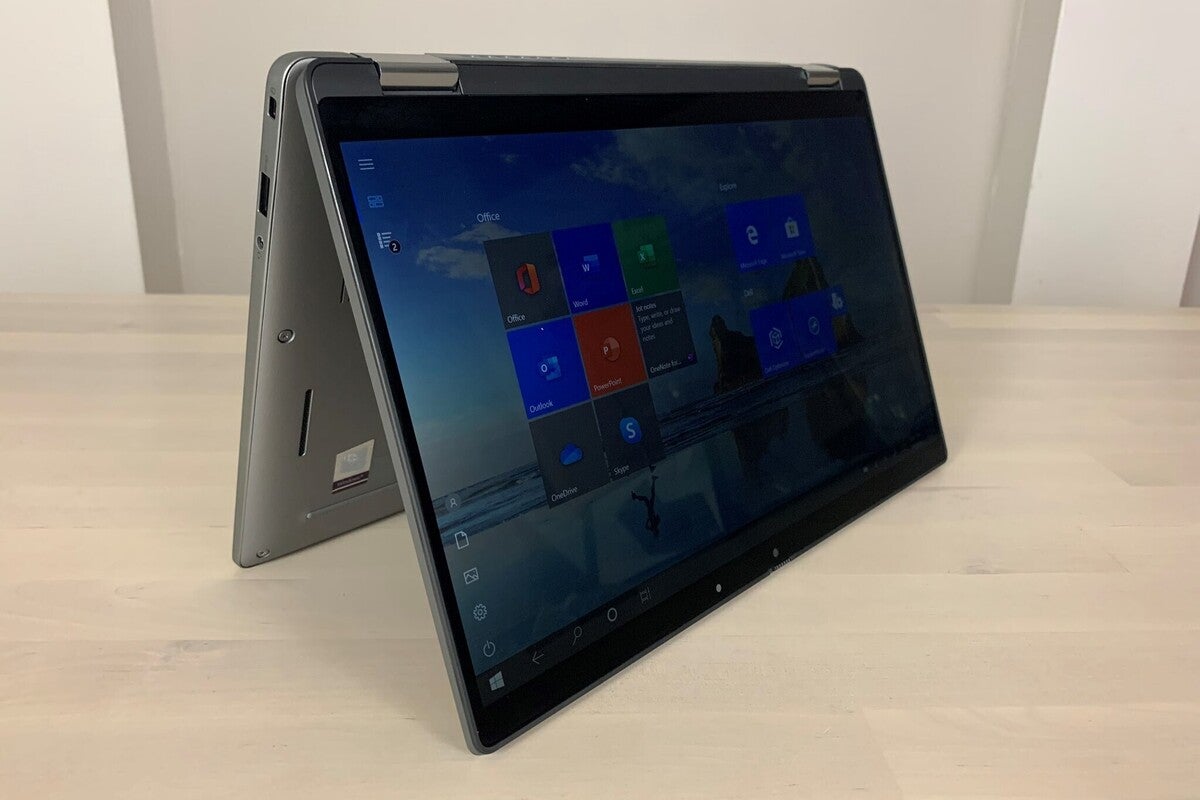 Ben Patterson/IDG
Ben Patterson/IDGThe Dell Latitude 7310’s 360-degree hinge gives you many choices for how to position the laptop.
The display has relatively slim left and right bezels, while the top and bottom bezels are a tad chunkier. Sitting at the top are two cameras: an IR module for facial recognition, and a 720p webcam with a physical shutter. The privacy shutter’s ridged slider is easy to use (ones we’ve tried on other models are far tougher to grip), although there’s no visual indicator of the shutter’s position.
Display
One of the key features of the Dell Latitude 7310’s display is its support for Dell SafeScreen, a technology that boosts your privacy by drastically narrowing the screen’s field of vision. Similar to how HP’s competing Sure View technology works, SafeScreen makes the Latitude 7310’s display appear much darker when viewed from the side, rendering text on the screen practically unreadable.
When I enabled the SafeScreen feature (by pressing the F9 key) and sat off to the side of the Latitude (imagine a nosy neighbor at a crowded Starbucks, an admittedly unlikely scenario during the ongoing pandemic), I couldn’t make out the text of the open Outlook email on my screen at all, nor could I read the numbers on an Excel spreadsheet.
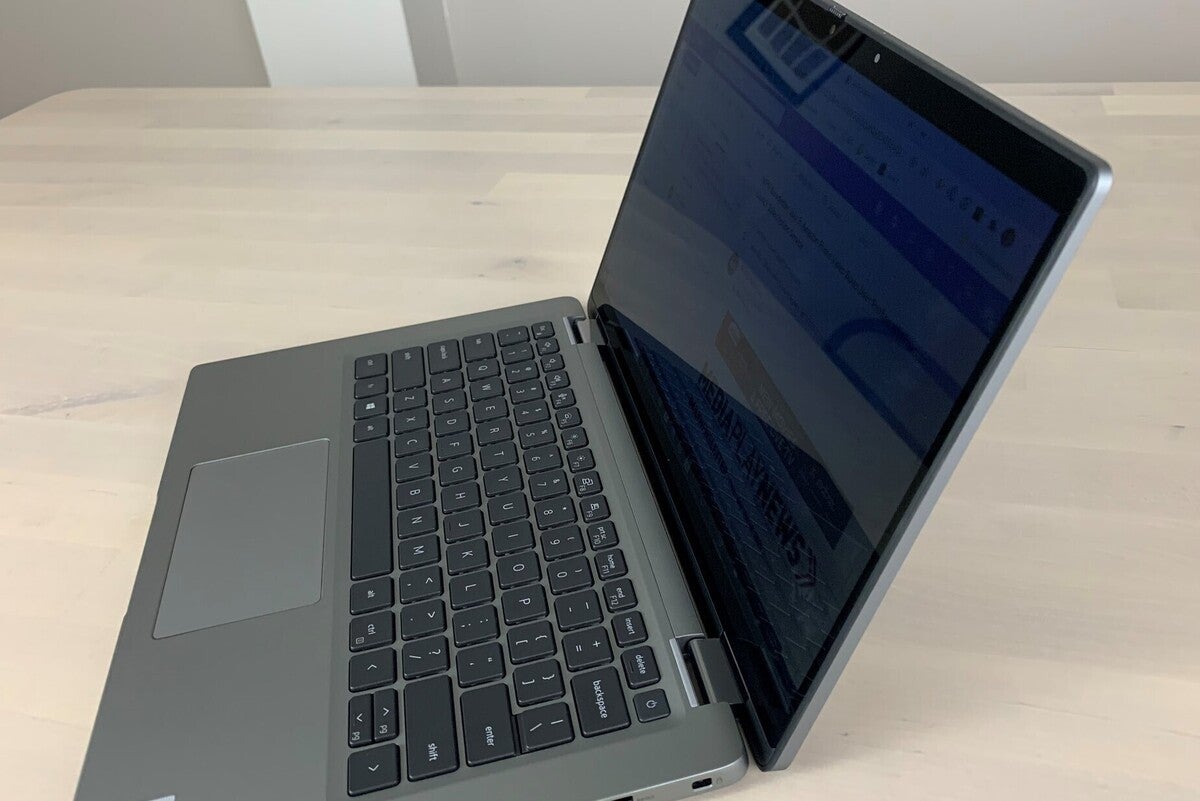 Ben Patterson/IDG
Ben Patterson/IDGWith Dell’s SafeScreen privacy feature enabled, nosy neighbors will have a tough time reading emails or spying data cells on the Latitude 7310’s display.
SafeScreen won’t hide everything from prying eyes. For example, I could faintly see the Outlook interface from my vantage point, and (in another test) I could easily identify a jumbo-sized image of Bill Gates’s face. The technology also does a better job at obscuring the screen when viewed from the sides than it does from the top or bottom. That said, I can report that with Dell SafeScreen switched on, the Latitude 7310’s side-to-side viewing angles are—intentionally—quite awful.
The Dell SafeScreen feature does have a slight impact on display brightness. According to our readings and with SafeScreen toggled off, the Latitude 7310 has a maximum screen brightness of 280 nits (at center of screen), a bit above our preferred setting of 250 nits for indoor viewing. With SafeScreen turned on, the 7310’s display brightness dimmed a tad to 275 nits—most noticeable if you rapidly turn SafeScreen on and off.
Keyboard, trackpad, speakers, and webcam
Most of the Dell Latitude models I’ve tested (including the aging Latitude that serves as my corporate laptop) come equipped with premium keyboards, and the Latitude 7310 is no exception. The keys feel solid and sturdy, with a little more travel than you normally get on laptop keyboards. The keys are also relatively quiet, which means your officemates (or, more likely, housemates) won’t shoot death rays in your direction if you’re typing away at a furious rate.
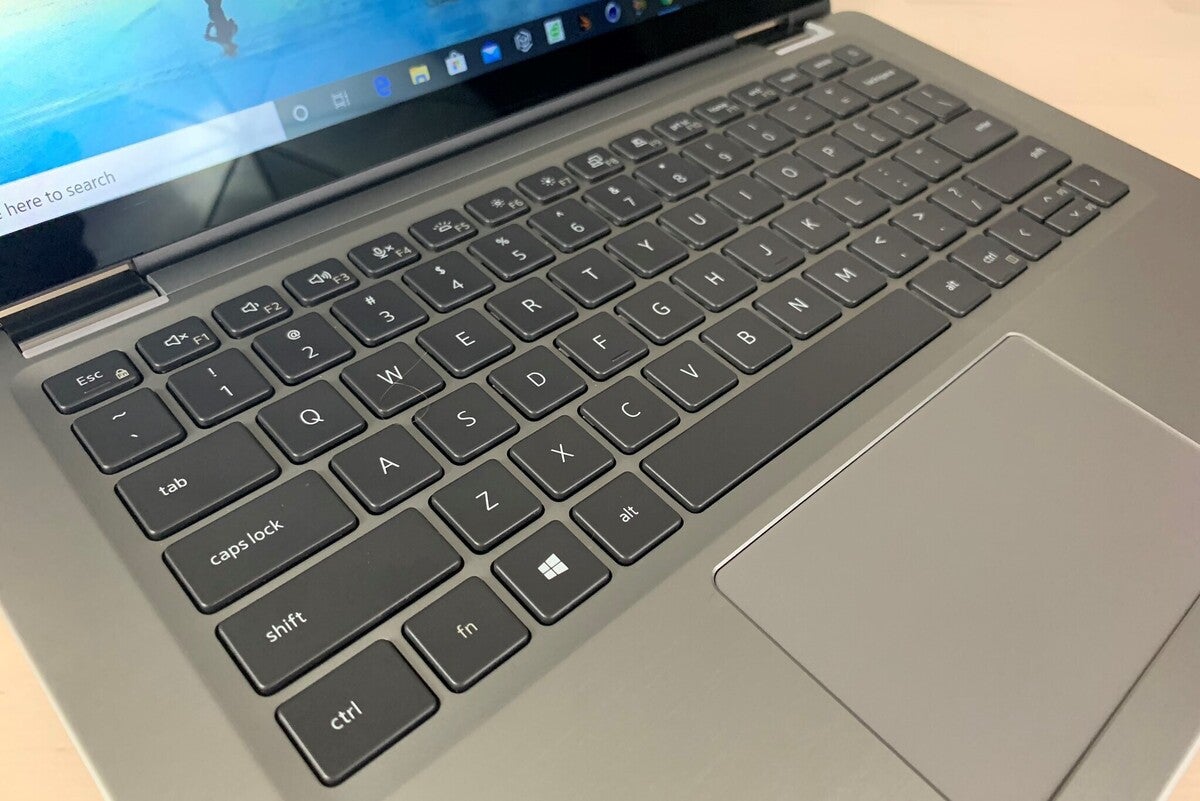 Ben Patterson/IDG
Ben Patterson/IDGThe Dell Latitude’s premium, quiet keyboard is a treat for serious typists.
The laptop’s power button sits in the top-right of the keyboard, but its stiff design makes it tough to press by accident. Some models of the Latitude 7310 have a fingerprint reader embedded in the power button, but not ours.
The Latitude 7310’s touchpad felt exceptionally smooth and precise to my fingertips, and it did a nice job of rejecting false inputs. Even when I smushed the bottom of both palms against the corners of the trackpad, the cursor refused to budge.
The laptop’s down-firing speakers are a cut above the (admittedly poor) norm. Cranking “Live and Let Die” by Paul McCartney and Wings, the twin drivers sounded reasonably detailed in the mid and high ranges, with a respectably wide soundstage for a laptop. But don’t get too excited: Bass response is practically (and unsurprisingly) non-existent. As usual, you’ll be better off plugging in a pair of cans or connecting a Bluetooth speaker, but as far as laptop speakers go, I’ve heard much worse.
The Latitude 7310’s 720p webcam turned in a solid performance during the half-dozen or so Zoom calls I joined during my testing. The 30-fps video that the webcam captured looked relatively vivid and detailed, if characteristically blotchy at times.
Dell Optimizer features
The Latitude 7310 series comes with a quartet of security and optimization features, bundled in the aptly named Dell Optimizer suite. Chief among them is ExpressSign-in, which automatically locks the Latitude’s screen and puts the laptop to sleep when you leave the vicinity, and wakes it back up and unlocks the screen when you return.
I had ExpressSign-in enabled for practically the entire time I was testing the Latitude, and it worked well. Sometimes, the feature went a little too far, locking the screen after I’d merely looked away for a few minutes, although it quickly woke and unlocked the screen when I turned to face the laptop again. You can specify how long it takes before ExpressSign-in locks the screen (from one to three minutes), and you can also snooze the feature for up to two hours.
While the concept behind ExpressSign-in is easy to mock—what, you can’t be bothered to lift your fingers to lock the screen?—it does serve a purpose beyond pampering lazy users. If you’re regularly dealing with sensitive material on your laptop, ExpressSign-in does a great job at enforcing screen security, cutting to a bare minimum those “oh, I’ll only be away for a second” lapses that leave your display open to prying eyes.
Besides ExpressSign-in, the Dell Optimizer suite also comes with ExpressResponse, an AI- and Intel Adaptix-powered technology designed to optimize your favorite applications (you’ll need to add your most-used programs to an ordered list), while ExpressCharge makes on-the-fly tweaks to your laptop settings to squeeze extra juice out of the battery. Intelligent Audio lets you specify how noisy your work environment is, automatically adjusting your audio settings so you can hear over the roar.
Ports
The Latitude 7310 comes with a relatively generous selection of ports (as it should, given its steep price tag), including (on the left side) a pair of Thunderbolt 3 ports, an HDMI 2.0 port, and a microSD memory card slot.
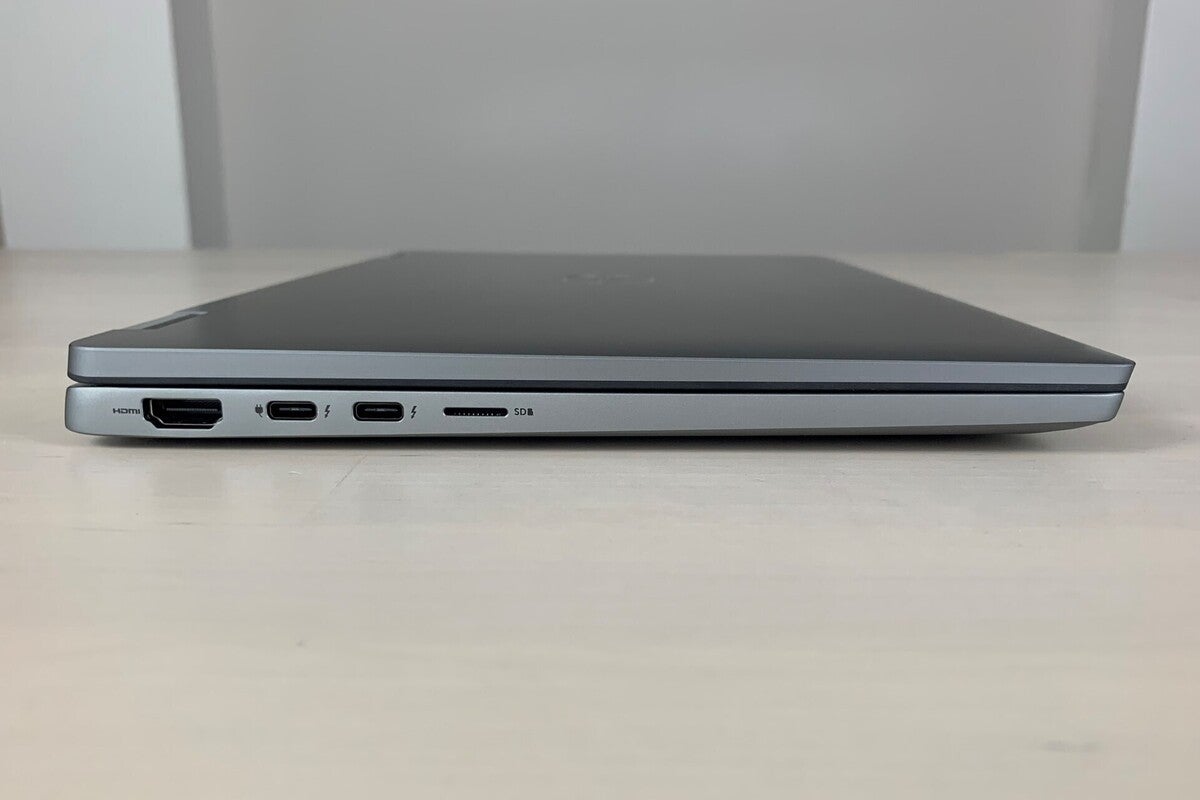 Ben Patterson/IDG
Ben Patterson/IDGThe left side of the Dell Latutide 7310 features a pair of Thunderbolt 3 ports, along with a full HDMI port and a microSD memory card reader.
On the right side sits a SuperSpeed USB 3.2 Gen 1 Type-A port and a combo audio jack, along with a wedge-shaped laptop security slot.
 Ben Patterson/IDG
Ben Patterson/IDGOn the right side of the Latitude 7310, you’ll find a SuperSpeed USB 3.2 Type-A port, a combo audio jack, and a laptop security slot.
We’re particularly pleased with the two Thunderbolt 3 interfaces, which give you options for connecting advanced display and storage devices. We’re also happy that Dell saw fit to include (at least) a single USB Type-A port for connecting legacy mice, printers, and other such peripherals.
Keep reading to see the Latitude 7310’s impressive Core i7 performance and more.
The Dell Latitude 7310’s privacy screen and proximity sensor will foil nosy neighbors, while its Core i7 Comet Lake processor will speed you though everyday and multi-core computing tasks.
Pros
- Solid and ruggedized shell
- Privacy screen thwarts prying eyes
- Proximity sensor locks and wakes the screen
- Impressive multi-core performance over time
Cons
- A tad heavy for its size
- Middling multi-core performance in short busts


